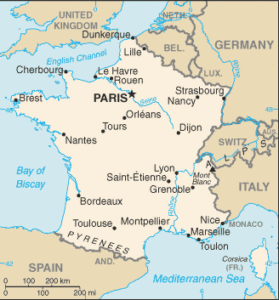 Jewish communities have existed in France since the first century. As in the rest of Europe, Jews were subject to persecution in France, especially during the Middle Ages. Riots, murders and expulsions were all-too-common occurrences. French Jews faced severe restrictions in where they could live and what jobs they could hold. One of the few places where they found refuge was in Provence. This refuge was in the Papal territories of Avignon and the adjacent Comtat Venaissan. Avignon and the Comtat were the property of the Catholic Church from the 13th century until they became part of France after the French Revolution. Jews here were referred to as les Juifs du Pape (the Pope’s Jews.) While they still faced restrictions in where they could live and what work they could do, life was better than elsewhere in France.
Jewish communities have existed in France since the first century. As in the rest of Europe, Jews were subject to persecution in France, especially during the Middle Ages. Riots, murders and expulsions were all-too-common occurrences. French Jews faced severe restrictions in where they could live and what jobs they could hold. One of the few places where they found refuge was in Provence. This refuge was in the Papal territories of Avignon and the adjacent Comtat Venaissan. Avignon and the Comtat were the property of the Catholic Church from the 13th century until they became part of France after the French Revolution. Jews here were referred to as les Juifs du Pape (the Pope’s Jews.) While they still faced restrictions in where they could live and what work they could do, life was better than elsewhere in France.
The Pope’s Jews were only allowed to live in: Avignon, Carpentras, Cavaillon and L’Isle-sur-la-Sorgue. Even within these cities, Jews were crammed together in carrières (ghettos) with narrow, congested, unsanitary streets and large gates that locked them in at night by Christian gatekeepers, whose salaries the Jews were obliged to pay. Cemetière juif de Carpentras (Jewish cemetery) dates back to the 14th century. The Carpentras synagogue the oldest in France is over 650 years old.
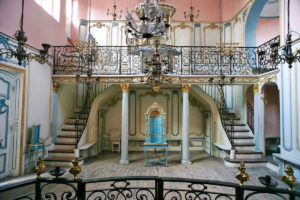 The French Revolution began the process of Jewish emancipation; French Jews were granted full citizenship in 1791. In 1818, schools were opened in Metz, Strasbourg and Colmar. Other Jewish schools were opened in Bordeaux and Paris. In 1930, a motion was in place to put Judaism upon an equal footing with Catholicism and Protestantism as regards support for the synagogues and for the rabbis from the public treasury. This motion was passed in parliament in 1831 and was ratified by King Louis Philippe.
The French Revolution began the process of Jewish emancipation; French Jews were granted full citizenship in 1791. In 1818, schools were opened in Metz, Strasbourg and Colmar. Other Jewish schools were opened in Bordeaux and Paris. In 1930, a motion was in place to put Judaism upon an equal footing with Catholicism and Protestantism as regards support for the synagogues and for the rabbis from the public treasury. This motion was passed in parliament in 1831 and was ratified by King Louis Philippe.
The Dreyfus affair was a major political scandal that convulsed France from 1894 until its resolution in 1906, and then had reverberations for decades more. The affair is often seen as a modern and universal symbol of injustice. The issue was blatant antisemitism as practiced by the Army. Captain Alfred Dreyfus, a young French artillery officer, was convicted of treason after being wrongly accused of having communicated French military secrets to the German Embassy in Paris. Dreyfus was sent to the penal colony at Devil’s Island in French Guiana, where he spent almost five years.
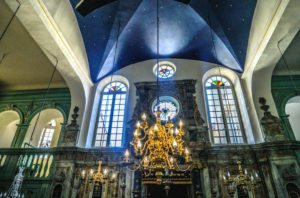 In 1896, evidence came to light identifying a French Army major named Ferdinand Walsin Esterhazy as the real spy. However, high-ranking military officials suppressed the new evidence and acquitted Esterhazy after the second day of his trial. The Army accused Dreyfus of additional charges based on false documents and in 1899, Dreyfus was returned to France for another trial. The new trial resulted in another conviction and a 10-year sentence but Dreyfus was given a pardon and set free. Eventually all the accusations against Alfred Dreyfus were demonstrated to be baseless. In 1906 Dreyfus was exonerated and reinstated as a major in the French Army.
In 1896, evidence came to light identifying a French Army major named Ferdinand Walsin Esterhazy as the real spy. However, high-ranking military officials suppressed the new evidence and acquitted Esterhazy after the second day of his trial. The Army accused Dreyfus of additional charges based on false documents and in 1899, Dreyfus was returned to France for another trial. The new trial resulted in another conviction and a 10-year sentence but Dreyfus was given a pardon and set free. Eventually all the accusations against Alfred Dreyfus were demonstrated to be baseless. In 1906 Dreyfus was exonerated and reinstated as a major in the French Army.
Before 1919, most Jews lived in Paris, with many being very proud to be fully assimilated into French culture. A more traditional Judaism was based in Alsace-Lorraine, which was taken by Germany in 1871 and recovered by France in 1918 following World War I. During the inter-war years, Jewish immigration from North Africa, Turkey and Greece increased once again. Immigration from Eastern Europe also skyrocketed, many came after the pogroms in the Ukraine, Poland and Russia. The trend continued especially after the United States prohibited free immigration in 1924.
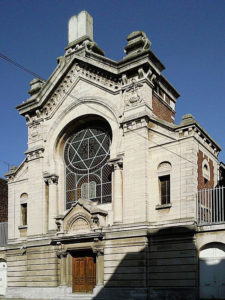 The Germans invaded France on May 10, 1940, and Paris fell on June 14. An estimated 300,000 Jews lived in France prior to the invasion. Two weeks later the armistice was signed, and France was divided into unoccupied and occupied zones, and Alsace-Lorraine was annexed to the Reich. A Vichy government was set up in France. Between September 1940 and June 1942, a number of anti-Jewish measures were passed, including expanding the category of who is a Jew, forbidding free negotiation of Jewish-owned capital, confiscating radios in Jewish possession, executing and deporting Jewish members of the resistance movement, establishing a curfew, forbidding a change of residence, ordering all Jews to wear a yellow badge and prohibiting access to public area. In March 1942, the first convoy of 1,112 Jews was deported to concentration camps in Poland and Germany. Beginning at 4:00 a.m. on July 16, 1942, 13,152 Jews were arrested, including 5,802 (44%) women and 4,051 (31%) children. The Vel’ d’Hiv roundup, codenamed Opération Vent Printanier (“Operation Spring Breeze”), was one of several Nazi-directed raids carried out by the French police aimed at eradicating the Jewish population in France. All were subsequently transported in cattle cars to Auschwitz for mass murder.
The Germans invaded France on May 10, 1940, and Paris fell on June 14. An estimated 300,000 Jews lived in France prior to the invasion. Two weeks later the armistice was signed, and France was divided into unoccupied and occupied zones, and Alsace-Lorraine was annexed to the Reich. A Vichy government was set up in France. Between September 1940 and June 1942, a number of anti-Jewish measures were passed, including expanding the category of who is a Jew, forbidding free negotiation of Jewish-owned capital, confiscating radios in Jewish possession, executing and deporting Jewish members of the resistance movement, establishing a curfew, forbidding a change of residence, ordering all Jews to wear a yellow badge and prohibiting access to public area. In March 1942, the first convoy of 1,112 Jews was deported to concentration camps in Poland and Germany. Beginning at 4:00 a.m. on July 16, 1942, 13,152 Jews were arrested, including 5,802 (44%) women and 4,051 (31%) children. The Vel’ d’Hiv roundup, codenamed Opération Vent Printanier (“Operation Spring Breeze”), was one of several Nazi-directed raids carried out by the French police aimed at eradicating the Jewish population in France. All were subsequently transported in cattle cars to Auschwitz for mass murder.
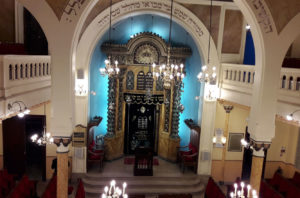 The French Resistance became a significant and broad-based movement whose members – Jews and non-Jews alike – engaged in armed underground activities and rescue operations. This period saw a change in France. For the first time, the deportations aroused substantial opposition to the Vichy regime among broad sections of the French public, since it was no longer possible to conceal the scale of the detentions and expulsions. Negative reactions began to be heard from members of the public. Many citizens reached out to provide help, whether by offering hiding places or by helping Jews cross the border into Switzerland. Public protests against the detention and deportation operations were also made by Church institutions in France, as archbishops and priests urged the faithful to help hide Jews, particularly children.
The French Resistance became a significant and broad-based movement whose members – Jews and non-Jews alike – engaged in armed underground activities and rescue operations. This period saw a change in France. For the first time, the deportations aroused substantial opposition to the Vichy regime among broad sections of the French public, since it was no longer possible to conceal the scale of the detentions and expulsions. Negative reactions began to be heard from members of the public. Many citizens reached out to provide help, whether by offering hiding places or by helping Jews cross the border into Switzerland. Public protests against the detention and deportation operations were also made by Church institutions in France, as archbishops and priests urged the faithful to help hide Jews, particularly children.
The citizens of the village of Le Chambon-sur-Lignon risked their lives to rescue and hide Jews in private homes, on farms in the area, as well as in public institutions. Whenever the Nazi patrols came searching, the Jews were hidden in the mountainous countryside. They also obtained forged identification and ration cards for Jews to use and helped them cross the border to the safety of neutral Switzerland. It was estimated that the people of the area of Le Chambon-sur-Lignon had saved between 3,000 and 5,000 Jews from certain death.
 Marcel Marceau, a Jew, whose father was murdered at Auschwitz, saved at least 70 Jewish children from the Nazis through risky border crossings during World War II, and his cousin Georges Loinger saved 350. They were both part of a secret unit within the Oeuvre de Secours aux Enfants, a Jewish relief group that smuggled Jewish children from occupied France to neutral countries. They evacuated Jewish children from a French orphanage and took them to the Swiss border. Marceau, used his acting skills to make the kids comfortable and to save their lives. He also forged identity documents.
Marcel Marceau, a Jew, whose father was murdered at Auschwitz, saved at least 70 Jewish children from the Nazis through risky border crossings during World War II, and his cousin Georges Loinger saved 350. They were both part of a secret unit within the Oeuvre de Secours aux Enfants, a Jewish relief group that smuggled Jewish children from occupied France to neutral countries. They evacuated Jewish children from a French orphanage and took them to the Swiss border. Marceau, used his acting skills to make the kids comfortable and to save their lives. He also forged identity documents.
 In 1939, Nancy Wake, an Australian, married the wealthy French industrialist Henri Fiocca. When Germany invaded France, they were involved with the resistance movement, helping thousands of Jewish refugees, escape to Spain. Nancy developed a reputation as the elusive “White Mouse,” and became a key Gestapo target. In 1943, aware that the Nazis were on her trail, she crossed the Pyrenees into Spain. Her husband was arrested, tortured and executed by the Gestapo. She became a spy and parachuted into France to coordinate attacks on German troops and installations prior to the D-Day invasion, leading a band of 7,000 resistance fighters.
In 1939, Nancy Wake, an Australian, married the wealthy French industrialist Henri Fiocca. When Germany invaded France, they were involved with the resistance movement, helping thousands of Jewish refugees, escape to Spain. Nancy developed a reputation as the elusive “White Mouse,” and became a key Gestapo target. In 1943, aware that the Nazis were on her trail, she crossed the Pyrenees into Spain. Her husband was arrested, tortured and executed by the Gestapo. She became a spy and parachuted into France to coordinate attacks on German troops and installations prior to the D-Day invasion, leading a band of 7,000 resistance fighters.
 In 1939, Hiram “Harry” Bingham IV was posted to the US Consulate in Marseilles, where he had responsibility for issuing entry visas to the USA. He personally toured some of the wretched internment camps and sought American aid to improve conditions. He helped many refugees to avoid internment and prepare for emigration and freely issued Nansen passports, a form of identity for stateless persons. Along with Varian Fry, he helped over 2,500 Jews to flee from France as Nazi forces advanced.
In 1939, Hiram “Harry” Bingham IV was posted to the US Consulate in Marseilles, where he had responsibility for issuing entry visas to the USA. He personally toured some of the wretched internment camps and sought American aid to improve conditions. He helped many refugees to avoid internment and prepare for emigration and freely issued Nansen passports, a form of identity for stateless persons. Along with Varian Fry, he helped over 2,500 Jews to flee from France as Nazi forces advanced.
 At the outbreak of World War II, Johan Hendrik Weidner Jr. was living in Paris. With the subsequent German occupation he moved to Lyon in the unoccupied part of France. In 1941, Jean founded “Dutch-Paris”, an underground network of which the location of his Lyonnaise textile business soon became its headquarters. In order to get passes to go in and out of the Swiss frontier zone, he set up a second textile shop in Annecy. Dutch-Paris became one of the largest and most successful underground networks for both escape via Switzerland and Spain and smuggling documents. The escape route was responsible for the rescue of more than 800 Dutch Jews.
At the outbreak of World War II, Johan Hendrik Weidner Jr. was living in Paris. With the subsequent German occupation he moved to Lyon in the unoccupied part of France. In 1941, Jean founded “Dutch-Paris”, an underground network of which the location of his Lyonnaise textile business soon became its headquarters. In order to get passes to go in and out of the Swiss frontier zone, he set up a second textile shop in Annecy. Dutch-Paris became one of the largest and most successful underground networks for both escape via Switzerland and Spain and smuggling documents. The escape route was responsible for the rescue of more than 800 Dutch Jews.
 Si Kaddour Benghabrit, a French Algerian, was the rector and head imam at the Paris Mosque. Many Oriental Jews, or Mizrahim, turned to him for help. It was not all that difficult for Benghabrit to fool the occupying authorities, as Oriental Jews do not look all that different to their Muslim brothers and sisters, they speak the same language, and they have similar names. He arranged forged documents for all the Jewish refugees that verified their supposed Muslim roots, thereby saving them from deportation to a concentration camp. It remains uncertain how many Jews Benghabrit managed to save, but it could have been up to 2,000 individuals. These not only included many resistance fighters, but also a large number of women and children. The hidden Jews used tunnels under the Mosque to access the Seine and be smuggled out of Occupied Paris.
Si Kaddour Benghabrit, a French Algerian, was the rector and head imam at the Paris Mosque. Many Oriental Jews, or Mizrahim, turned to him for help. It was not all that difficult for Benghabrit to fool the occupying authorities, as Oriental Jews do not look all that different to their Muslim brothers and sisters, they speak the same language, and they have similar names. He arranged forged documents for all the Jewish refugees that verified their supposed Muslim roots, thereby saving them from deportation to a concentration camp. It remains uncertain how many Jews Benghabrit managed to save, but it could have been up to 2,000 individuals. These not only included many resistance fighters, but also a large number of women and children. The hidden Jews used tunnels under the Mosque to access the Seine and be smuggled out of Occupied Paris.
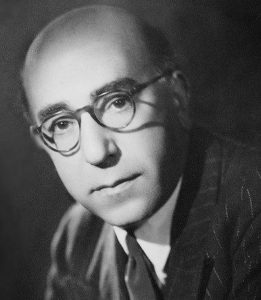 Another man who took similarly great risks in Paris during the Second World War, was Abdul Hussain Sardari. At the time, he was head of the Iranian Consulate in Paris. Sardari was able to provide passports and travel documents needed for safe-passage through Nazi-occupied Europe. Sardari used his influence and German contacts to gain exemptions from Nazi race laws for more than 2,000 Iranian Jews. Despite being stripped of his diplomatic immunity and status, Sardari remained in France helping the Iranian Jews, at considerable risk to his own safety, using money from his inheritance to keep his office going.
Another man who took similarly great risks in Paris during the Second World War, was Abdul Hussain Sardari. At the time, he was head of the Iranian Consulate in Paris. Sardari was able to provide passports and travel documents needed for safe-passage through Nazi-occupied Europe. Sardari used his influence and German contacts to gain exemptions from Nazi race laws for more than 2,000 Iranian Jews. Despite being stripped of his diplomatic immunity and status, Sardari remained in France helping the Iranian Jews, at considerable risk to his own safety, using money from his inheritance to keep his office going.
Several of the men responsible for the deportation of French Jews were later brought to trial: The Vichy minister responsible for ordering the deportations, Pierre Laval, was tried in 1945 and found guilty of treason. He tried to commit suicide by swallowing a cyanide capsule, but was revived by doctors, and later executed by firing squad on October 15.
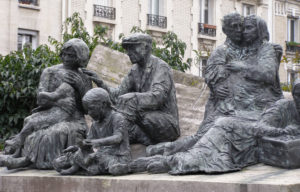 France became a haven for postwar refugees and within 25 years its Jewish population tripled. In 1945, 180,000 Jews were living in France, and, by 1951, the population reached 250,000. An influx of North African Jews immigrated to France in the 1950’s due to the decline of the French empire. Subsequent waves of immigration followed the Six-Day War, when another 16,000 Moroccan and Tunisian Jews settled in France. Hence, by 1968, Sephardic Jews were the majority in France. These new immigrants were already culturally French and needed little time to adjust to French society.
France became a haven for postwar refugees and within 25 years its Jewish population tripled. In 1945, 180,000 Jews were living in France, and, by 1951, the population reached 250,000. An influx of North African Jews immigrated to France in the 1950’s due to the decline of the French empire. Subsequent waves of immigration followed the Six-Day War, when another 16,000 Moroccan and Tunisian Jews settled in France. Hence, by 1968, Sephardic Jews were the majority in France. These new immigrants were already culturally French and needed little time to adjust to French society.
From the late 70’s, and 80s, a spate of racist and anti-Semitic attacks were carried out. On October 3, 1980, a bomb exploded outside a Paris synagogue, killing four people. Terrorism and anti-Semitism continued to be a problem. Violence in France, especially directed at Jews, has been primarily perpetrated by Muslims. On March 19, 2012, a radical Muslim fired at children entering a Jewish school in Toulouse, killing a 30-year-old teacher and his three- and six-year-old children. A third child, aged eight, was also murdered and a 17-year-old student was seriously injured. After that deadly attack, 90 anti-Semitic attacks were recorded in the next 10 days. In October, a kosher grocery store was bombed in Sarcelles wounding two people. Two days later, while the perpetrators of the Charlie Hebdo massacre were surrounded by police, an assailant took hostages at a Kosher supermarket in eastern Paris. After murdering four of the hostages, the suspect was killed when police stormed the market.
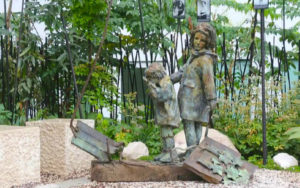 Three soldiers patrolling outside of a Jewish Community Center in Nice, Southern France, were attacked by an individual wielding a knife on February 3, 2015. A rabbi and his son were attacked outside of a synagogue in Marseille in mid-October 2015. On January 11, 2016, a 35-year old Jewish teacher who was wearing a kippah, was assaulted by a teenager wielding a machete. Seventy-three-year-old French Jewish politician Alain Ghozland was found dead in his apartment from multiple stab wounds on January 12, 2016. On April 4, 2017, 65-year old Jewish mother Sarah Halimi was assaulted in her third-floor apartment and beaten savagely before being thrown out the window to her death. In January 2018, two Jewish children were assaulted in separate attacks. A 15-year-old Jewish girl was slashed in the face while walking home from her private Jewish school. An 8-year-old Jewish boy wearing a kippah while walking to a tutor who was beaten by two teenagers. Jewish Holocaust survivor Mireille Knoll was murdered in her Paris apartment on March 24, 2018, in what French authorities deemed a religiously-motivated hate crime. The 85-year old victim had been stabbed to death and badly burned when the attackers apparently tried to set fire to her apartment. As a result of continued hate crime, over 20,000 French Jews made aliyah to Israel between 2000 and 2015.
Three soldiers patrolling outside of a Jewish Community Center in Nice, Southern France, were attacked by an individual wielding a knife on February 3, 2015. A rabbi and his son were attacked outside of a synagogue in Marseille in mid-October 2015. On January 11, 2016, a 35-year old Jewish teacher who was wearing a kippah, was assaulted by a teenager wielding a machete. Seventy-three-year-old French Jewish politician Alain Ghozland was found dead in his apartment from multiple stab wounds on January 12, 2016. On April 4, 2017, 65-year old Jewish mother Sarah Halimi was assaulted in her third-floor apartment and beaten savagely before being thrown out the window to her death. In January 2018, two Jewish children were assaulted in separate attacks. A 15-year-old Jewish girl was slashed in the face while walking home from her private Jewish school. An 8-year-old Jewish boy wearing a kippah while walking to a tutor who was beaten by two teenagers. Jewish Holocaust survivor Mireille Knoll was murdered in her Paris apartment on March 24, 2018, in what French authorities deemed a religiously-motivated hate crime. The 85-year old victim had been stabbed to death and badly burned when the attackers apparently tried to set fire to her apartment. As a result of continued hate crime, over 20,000 French Jews made aliyah to Israel between 2000 and 2015.
 Today more than 450,000 Jews live in France, 277,000 live in Paris. There are 230 Jewish communities, including Paris, Marseilles (70,000), Lyons (25,000), Toulouse, Nice and Strasbourg. Most French Jews send their children to public schools, although there is increased attendance in Hebrew day schools; today close to 25% of school-age children attend full-time Jewish schools. In Paris alone, there are 20 Jewish schools in the day school system. Hebrew is also being offered as a foreign language in many state high schools. In 1985, a new library sponsored by the Alliance Israelite Universelle (AIU) opened. It is now the largest Jewish library in Europe.
Today more than 450,000 Jews live in France, 277,000 live in Paris. There are 230 Jewish communities, including Paris, Marseilles (70,000), Lyons (25,000), Toulouse, Nice and Strasbourg. Most French Jews send their children to public schools, although there is increased attendance in Hebrew day schools; today close to 25% of school-age children attend full-time Jewish schools. In Paris alone, there are 20 Jewish schools in the day school system. Hebrew is also being offered as a foreign language in many state high schools. In 1985, a new library sponsored by the Alliance Israelite Universelle (AIU) opened. It is now the largest Jewish library in Europe.